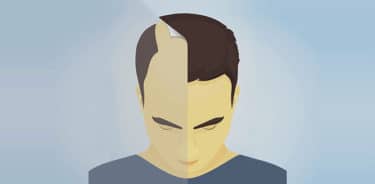Hair transplant is an operation that moves hair follicles from one area and implants in an area where hair loss is happening. It solves the hair loss problem permanently, especially in case of male baldness or accidents and burns. The most promising side of this operation is that hair grows naturally in the transplanted area. Follicular unit extraction (FUE) is the most popular method used, because it achieves a faster and better quality. It is a painless method and does not leave any significant trace, as no incision is made.
Table of Contents
Hair transplant
It is a surgical procedure that aims to treat hair loss problem permanently. It takes the skin (graft) with hair from the (donor) area, and transplants it to the (recipient) area where there is the hair loss. Donor hairs, genetically resistant to hair loss, are usually picked from the neck and the sides of the ears.
If hairs in the donor area are not sufficient, other hairs such as legs, chest or beard can be taken. It is done only with the person’s own hair, not anybody else. This particular surgery belongs to the field of aesthetics and plastic surgery. (1)
Why hair transplant?
It is done to solve the problem of regional baldness and thin hair. It can also be applied to the problem of eyebrows, beard and mustache.
Who benefits hair transplant?
Healthy men and women who are between 20-75 years old with inherited regional hair loss or the following problems:
- Androgenetic alopecia (inherited baldness)
- Scar from burns or injuries
- Face lifting, brain surgery etc.
- History of an infection
- Pulling the hair tightly (traction alopecia)
The person who will undergo hair transplant surgery should have sufficient donor hair to cover the areas of baldness.
Hair transplantation is not applied to people with chronic and serious conditions such as hypertension, diabetes and kidney failure. It also does not work for hair loss caused by chemotherapy or ringworm.
What causes hair loss?
It may happen for many reasons. Important ones are:
- Genetics
- Hormonal (lack of testosterone)
- Menopause
- Pregnancy
- Stress
- Malnutrition
- Drugs
- Diseases
- Environmental factors
Procedure of hair transplant
- The area of hair loss is analyzed. The amount of grafts is determined, and the new hairline is agreeed to make the hair look natural.
- Scalp is thoroughly cleaned with a particular medicine to avoid the development of an infection.
- The area where graft will be collected is anesthetized with sedation.
- Grafts collected from the donor site are preserved in a special solution.
- After the recipient area is anesthetized, the channels where hair follicles will be put are opened.
- Grafts are placed in the opened canals. (2)
How long does hair transplant surgery take?
This surgery usually does not require hospitalization. Usually the process takes 6 to 9 hours. It may vary depending on the amount of hair follicle to be placed and the method to be used. If the area to be treated is large, 2 or more sessions may be required at regular intervals.
Does hair transplant surgery hurt?
Because both the donor and recipient areas are anesthetized with sedation, no pain is felt during hair transplant, but painkillers should be taken if there is any pain.
Methods of hair transplant
There are 2 essential methods in order to collect hair from the donor area: (3)
- Follicular unit transplantation (FUT)
- Follicular unit extraction (FUE)
A follicular unit is a natural hair structure where multiple hair follicles exist together.
FUT method hair transplant
Hair follicles are taken from the donor area in the form of strips by the FUT method, and the grafts in these strips are separated, and then planted in the channels opened in the recipient area. The process in this method is as follows:
- Rectangular skin of 15-30 cm in length and 1-1.5 cm in width is removed from the neck and lateral regions of the head after being anesthetized with sedation. The amount of strips to be removed varies depending on the amount of hair follicle to be collected.
- After collecting process is done, the area with the incision is aesthetically stitched and wrapped with a bandage.
- The hair follicles (grafts) gathered through incisions are separated from the skin pieces and preserved in solution.
- After the area is anesthetized locally, channels with the size of a needle head are opened as many as the number of grafts removed with micro blades or needles.
- The hair follicles are put in the canals and the process is finished.
This method is an unshaved version. The head does not need to be shaved, only the area where the strips are taken out is trimmed. A thin linear trace remains in the donor area where the hair will grow after a while. Healing time of the wound is approximately 2 weeks.
FUE hair transplant
In the FUE (Follicular Unit Extraction) method, hairs are picked up one by one from the donor area and transplanted into the channels that are opened in the recipient area. It works as follows: (4)
- The whole head is shaved.
- A special puncturing tool called punch is used in order to get hair grafts one by one under a local anesthesia. In the classical FUE method, punch is used manually and grafts are collected with a pair of tweezers.
- The grafts are placed in small canals opened up in the scalp by the lateral slit technique. This technique orients the canals according to the size and shape of the graft.
It is the most popular hair transplant method, since a large number of hair follicles are taken out and placed in the opened channels without having a scar by a seamless technique. With the technological advances, many medical devices are employed in the FUE method.
Micro-motor FUE
In FUE method, punches are inserted on the electric micromotor and positioned according to the orientation and angle of the hair, and pricked into the scalp to pull the hair follicles. Thus, by the help of punches, the circumference of the root is loosened by cutting out cylindrically. After hair follicles are loosened, they are collected one by one with tweezers.
Punches inserted to the end of the micro motor are changed according to the hair structure of the person, preventing damage to the hair follicles. For example, punches with larger diameters are used for thick hairs and small diameters for thin hairs. (5)
Robotic FUE
This medical device supervised by a physician has a computer-based system. Ends of this device form rounded areas around the hair follicles, pick them up one by one and put them in its inner chamber. Robotic FUE micro-incisions help to get more grafts without making any damage by its special collecting style and vacuuming units. Only people with black or brown straight hair can benefit from this technology. (6)
DHI hair transplant
A sharp-tipped tool known as the Choi needle, similar to the pen, is used. Hair follicles collected from donor area are inserted inside tool and planted directly in the recipient area with special tips without making any holes. This minimizes the length of time which the grafts are out and ensures that they stay stronger.
Sapphire FUE
The channels for transplant in which the hair follicles harvested in Sapphire FUE are opened with the tips that are produced from real sapphire. This tool minimizes the crusting of wounds and accelerates healing process by opening up the channels in micro-sizes.
Also, there is a Gold technique in which the devices used for hair transplant are made of gold.
Hyperbaric FUE
In this version of FUE method, after the hair transplant is done, the patient is given a hyperbaric oxygen treatment, and a pure oxygen inhalation for a while in order to increase the oxygen level in the blood. Hair follicles improve faster when oxygen treatment is applied at regular intervals.
Laser FUE
Laser FUE (Laser assisted hair transplant surgery) opens up the channels in the target area with low intensity laser beams. The laser vaporizes the tissues and forms 1-1.3 mm channels. Thus, blood circulation under skin increases, which makes the likelihood of the hair follicles to adapt to their new place higher. Because blood vessels clot during sowing, bleeding does not happen.
Laser FUE is not a widely used method and the experts in this field have different opinions about the results. The main criticism is that as the laser beam will burn and damage the blood vessels, blood circulation will not increase and therefore the likelihood of hair follicles to adapt to their new place will be low.
Advantages of FUE hair transplant
- Hair follicles are taken out one by one without incision. White spots remain where the hair follicles are taken and these are not noticed from the outside when the hair grows.
- More hair follicles can be picked up in a shorter time, and planted in the area to be transplanted.
- Since there is no surgery involved, if there will be an extra session, no need to wait a long time between sessions. The procedure can be applied with 1 day intervals depending on the patient’s condition.
- Grafts taken from the donor area can also be used for mustache, eyebrow and beard transplants.
- There is no pain or loss of tissue sensation after hair transplantation.
When does hair grow after hair transplant?
After 3 to 6 months, new hair starts to grow naturally. The exact result is observed after about 12 to 18 months.
Tips for hair transplant
Since hair transplant is a serious operation, the surgeon’s experience, the operation team, medical devices, hospital hygiene and other conditions should be thoroughly investigated for the success of this procedure.
Before hair transplant
When you decide on the operation, you should pay attention to:
- Do not smoke and drink alcoholic or caffeinated beverages one week before.
- Tell your doctor if you are taking any medication for heart diseases, diabetes or high blood pressure.
- Do not use anticoagulants, such as aspirin, two weeks before the operation. Do not use multivitamins containing vitamin B and vitamin E since it may increase bleeding.
- Wash your hair before the surgery, and do not use chemical products such as gel, spray, etc.
- Since the operation takes a long time, you can be on a full stomach before operation starts.
- If sedation will be given during surgery, ask someone to pick you up from the clinic as the effect may last for 24 hours.
- Wear buttoned cloths such as shirts or cardigans when coming to surgery.
After hair transplant
Until hair follicles are settled in their new places, you should be careful at least 15 days after the operation. Here’s what to do:
- Do not wash your hair for three days and do not get them contact with water, especially in the area where the hair is planted. Wash your hair gently with your fingertips using the shampoo and lotion recommended by your doctor. Your doctor will do the first washing.
- After washing, dry your hair gently with a towel and try not to use a hair dryer. If you have to, do not bring the machine too close to your head.
- Avoid sports such as football that can cause concussion. Transplant area should be protected against all kinds of trauma possibilities especially in the first 2 weeks.
- Use a hard and small pillow to avoid any damage to the transplanted area. Lie on your back as much as possible.
- Try to wear buttoned clothes for a while.
- You can use a hat to protect your hair from external factors such as sun, rain or dust.
- Stay away from environments like sea, hot bath or sauna.
- Scabs usually end in 10 days after operation. If it continues more than 15 days, consult your doctor.
Does transplanted hair fall out again?
After a few weeks, the transplanted hair may fall and this event is called Shock Loss, but about 4 months later permanent hair starts to grow.




